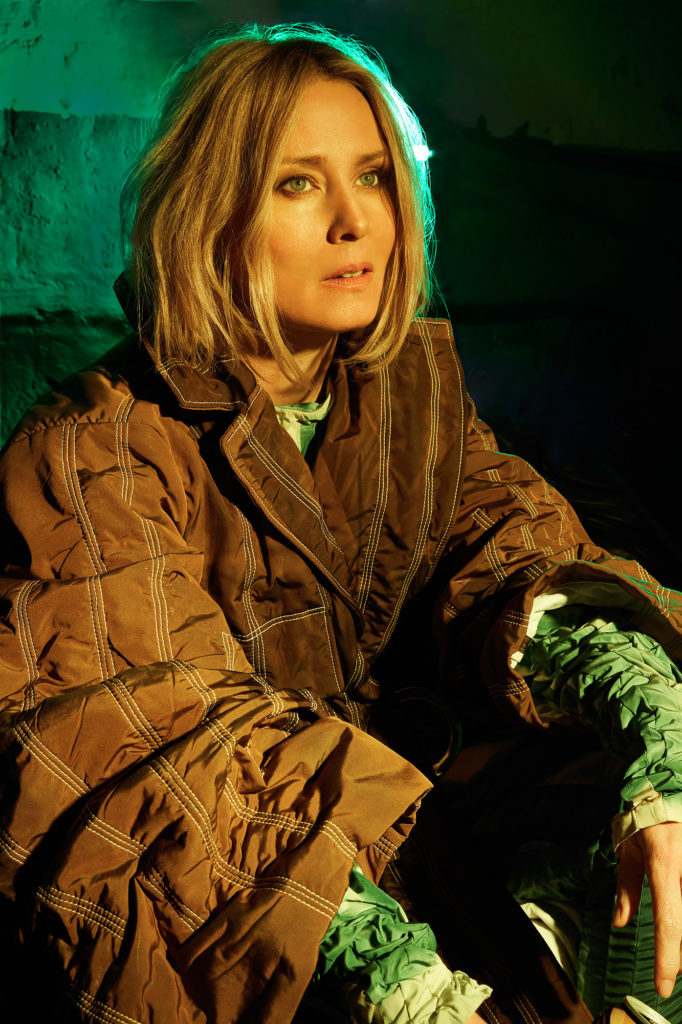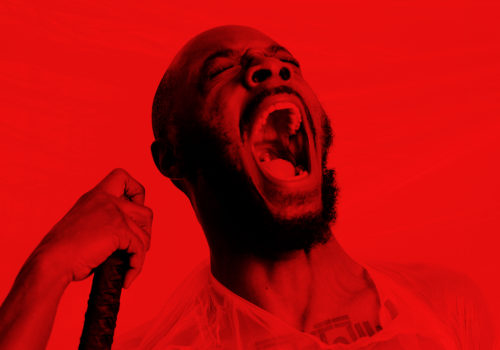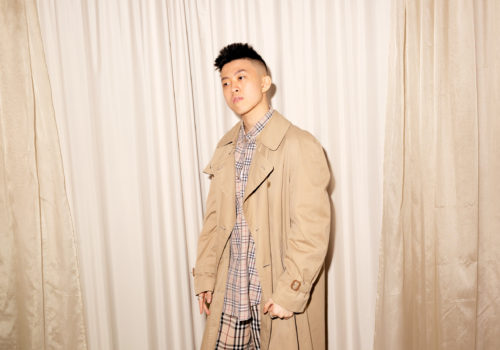Roisin Murphy is the Irish pop enigma
Words: Cóilí Collins
Photography: Nicole Nodland
Following the announcement of this year’s Choice Music Prize nominees, we are revisiting our archives and dusting off some of our favourite features with the selected acts.
For veteran music heads, Roisin Murphy is probably the most familiar name on the album nominations. In an era of Tik Tok-fuelled overnight success, music can often be dictated by popular trends and acts can disappear just as quickly as they blow up. Roisin’s recent dance floor reinvention is testament to her ability to serve timeless music that bumps trends in favour of immortality. Revisit our chat with the pop sensation that explores the essence of one of Ireland’s greatest songwriters.
The past three decades have seen some of the most colourful and influential electro-pop icons come and go. We’ve had Björk, Lady Gaga, Fever Ray, Tiga, Goldfrapp and a whole host more, all of whom having attracted the allure of the glaring mainstream spotlight while consistently maintaining a nod from the underground’s often hard to please heads. Having our own queen of the left-field shouldn’t be something surprising to us eccentric Irish.
Phone interviews are always quite tricky to manoeuvre, especially when the voice on the other line belongs to someone that has been in the music industry longer than they haven’t. Murphy’s voice meanders through a melange of Arklow edge, Manchester grit and London grandeur from the off as she dips in and out of the eventful string of happenings that have landed her as one of the premiere vocalists and pioneers of electronic music. Her tendency to not go into detail is a particularly Irish trait she most definitely never lost, despite her relative lack of time on the island, but it adds colour to an interview medium that can be mundane at the best of times.
Despite having only resided in County Wicklow until she was 12, Murphy is quick to point out that her Irish heritage and upbringing is what brought on her own song-writing ability. That coupled with the fact that her musicality was truly awakened within the depths of Manchester right during the boom of Acid House 30 years ago makes the uniqueness of her work easier to understand.
“Maybe I did feel that being Irish was incongruous with making electronic music for a long time; it isn’t now at all. It was jarring for people to put the two concepts together. At the time, The Cranberries were around, The Hothouse Flowers and of course, U2. That sort of thing was considered what Irish music was, so there was definitely an incongruity as regards Irish music in the 90s and making experimental, electronic music, I guess.”
“I’m not being full of shit, but I’m really proud to be Irish. Every single person that I was brought up around were singing songs constantly. I guess what I am, wherever I’ve been within genres, is a songwriter, that’s always been the biggest part of my musical DNA and that’s the Irish part of me! Even if DJ Koze is talking about why he likes working with me he’ll say, ‘I just like her Irish sorrow’,” She laughs, as if to say ‘Would you believe that?’. “I think the way I look at things and the way I am musically is more Irish than anything else. I’ve never been one to go around and try and make money out of that or push that, but between me, you and the wall, it still is the biggest part of me musically.”
The conversation twists, and without being asked Murphy walks me down her memory lane. “A good aul story”, filled full of euphoria, great timing and the slightest undertone of tragedy. Not a particularly new story to any Irish Joe Soap, this one just happens to be one of the most recognisable voices in modern music.

“Growing up in Ireland that time was weird because it was as if we were in some sort of MGM musical where everyone sang their fucking heart out. All the people in my family, whether they’re musical or not, they all love music. I was really steeped in it and the music that was going on at the time. I was getting a lot of Queen and even Jamaican music because one of my cousins was into reggae music. My grandfather used to sing all this old sort of Italian music, so in terms of songwriting I was given an awful lot by osmosis because of where I was born. I was then super lucky to have decamped to Manchester just before I turned into a teenager. That’s what I’m about, different things all clashing together.”
“It’s a good aul story, my musical journey. From there to Manchester I became obsessed and that helped me draw out my identity from other people. I didn’t have to fit in. The pain of trying to fit in as a teenager is bad so when you find music and say, ‘Fuck it I don’t have to’, it’s such a liberating thing, it’s incredible. That was a very easy thing to find in Manchester; I saw Sonic Youth play live and that was it, I was smitten with the culture of finding the music that not everyone was into, but enough people to bring those bands into town. After that I started getting into clubs; there was every single kind of conceivable clubs available to me in Manchester. Even then, my parents broke up and that was a tragedy and they all went their own different ways which is a different story, but I ended up in Manchester, on my own, when I was 15 and got a flat as soon as I turned 16. That meant that I could go wherever I wanted and nothing ever happened to me!” She exclaims, emphasising that ‘me’ with another ‘would you believe?’ tone. As if the individual on the phone had just woken up to the illustrious life she finds herself a part of today with no forewarning.
“I went to all these mad places,” she tells me.
“I was in clubs where bullets were flying and shit like that and nothing ever happened to me, it was just great stuff that happened to me. I met a guy who was on an architecture course that wanted to move back to Sheffield, so I moved there and I went from having all my friends in Manchester who were obsessed with music but not into making it, to Sheffield where it seemed like everyone was making music. I accidentally started to make music and I owe my whole existence to music. I’m the luckiest person going, I guess.”
Growing up in Ireland that time was weird because it was as if we were in some sort of MGM musical where everyone sang their fucking heart out.
Roisin Murphy
The man mentioned happened to be Mark Brydon, and the pair would form Moloko and release a string of hits still inhabiting the USBs of young DJs across Ireland. Many of whom were unaware that the vocals are indeed from one of their own.
“I think we were so madly in love with each other that you just want to be close by,” she reminisces on her work with Brydon.
“I turned around to him when we were offered the deal and I said, ‘What are you talking about Mark, why do you want me to do this, are you crazy?’. Six albums they were offering us to do at the time and he said a very true thing, ‘If we manage to do six albums Róisín then something will have gone very right, so if it goes wrong it goes wrong and that’s fine’.”
Her relationship with Brydon ended around the release of their ‘Statues’ album in 2003 and after one last tour, Moloko was no more. This led to a fruitful, but more enigmatic, solo career. One we’re still luckily witnessing.
“At [the time of] ‘Overpowered’ [2006] that was me at maximum popstar mode; all the fashion and everything, but I’m standing here in Soho now on the phone to you with an anorak on and a hat and nobody knows who I am, and that’s who I am. In my mind I’m just like the producers I work with, I’m not like all those popstars…”
Pausing for a second, she backtracks, “I’ve got plenty of bravado, I’ve got that in spades.”
I’ve been to all kinds of clubs, all kinds of strands of society; I can sit down with posh people, I can get down with all sorts of rough people. I’m an escaped mink from a mink farm and I can go wherever I like.
Roisin Murphy
Laughing at that admission of frivolity she touches on that part of Róisín Murphy that has always made her a hit with the cool kids, but acceptable enough to mix with the voices of radio, all while avoiding any sort of plastic Paddy label.
“I’m a mink, you know? I duck and dive, I can go anywhere! I can go up, down and sideways and I pride myself on that, I’ve been to all kinds of clubs, all kinds of strands of society; I can sit down with posh people I can get down with all sorts of rough people. I’m an escaped mink from a mink farm and I can go wherever I like and that’s how I feel! I don’t feel posh, I don’t feel middle class, I don’t feel working class and I want to keep it like that. I’m Arklaaaa,” she says in a perfect, droning Arklow accent. “I’m an Arkla mink!”
She turns her attention to the Róisín Murphy we see on stage and screen, head to toe in outlandish attire.
“There’s a part of me that’s very much a muse, so people that are creative, not all of them but enough to keep me going, are attracted to whatever energy it is that I have. So I’ve been lucky in that way that people like Matthew Herbert, or Maurice Fulton, or DJ Koze might find some inspiration in me and that’s how it works, and I obviously find something in them too, it goes both ways. But I suppose I’m a catalyst in that way and then they’re catalysts to me. They know once their job is done that I will do my utmost within the year and a half that I have that music to put together a live show to the best of my ability, to put together artwork the best I can possibly pull off and now in the last few years, direct the videos and conceptualise the whole thing. It’s very hard work, especially on the kind of budgets that I’m working with, but it’s very rewarding. It’s a two way street.”

The mention of working with Fulton brings up the topic of new music, something Murphy most definitely has in abundance, with her new single ‘Jacuzzi Roller Coaster’ the latest in a long line of EP releases that will ultimately culminate into an eight-track collection. Having kicked off her career in an era where floppy discs were the common digital storage medium, Murphy’s adaptation to social media has been impressive. Each new track has its own individual artwork, making them incredibly online-friendly, all while nodding back to her rave-entwined roots.
“Braulio Amado takes all the credit for the graphic design, but I can take credit for finding him and for the direction and overviewing and the way that it needed to be released. Maybe I shouldn’t because it might be better as regards sales if it was an album, but it wasn’t an album in my mind. I couldn’t finesse this music to that point, perhaps I might have if Maurice [Fulton] let me take it away and mix it somewhere else and fuck around with it longer. Perhaps it might have turned into a Róisín Murphy album. He was saying, ‘No you can’t, I played it in the club last week and it worked so don’t touch it’, and that’s what this is about, it’s about club culture. I started with the idea of it being eight tracks broken into four releases and 12 inches so that was the first concept and then after that I wondered how to artwork it. Myself and my partner started looking for guys that did the original Trax Records and old label graphics, wondering if we could find the people who did the graphic design back in the day and we couldn’t because they’re really unsung heroes.
“In that search we found the Braulio stuff, which had that energy; that real authentic club energy that was still modern at the same time, so he was ideal. He was the perfect guy to do it. The nice thing about having it as four releases; two tracks on each release is that you have two covers on each release as well which means I have eight original covers instead of one out of Braulio, he’s been an absolute treasure. There are people I’ve worked with over the past year that have really let me down timewise or lied to me as regards what was possible, which added stress, but Braulio, you ask him once and the thing is done and he’s a genius. I love him with all my heart and soul.”
The Wicklow artist laughs off my praise towards her online presence, despite a new podcast which has seen her in conversation with Groove Armada and Little Dragon.
“I wouldn’t say I’m doing really well on social media! I’m on Instagram and I make these little films and make sure that everything I put up there is something I care about. It grows by about a thousand people every month and then I just happen to be flicking around Instagram and you find some Italian model that you’ve never heard of and she’s got about 6,000 likes on her latest post!”
She then continues to laugh at the fact that her multiple on stage outfit changes may well make her one of the most palatable artists for The Gram. With that she bids adieu and her voice flutters away in a gracefully jarring collection of farewells, “Bye, bye, bye”.
Murphy may well remain the enigma of popular Irish music for the foreseeable future, but she holds the crown as the queen of Ireland’s often discordant, but always captivating, left-field. Acting as a non-blatant firestarter for a country now home to a generation obsessed with computer-generated sounds.


